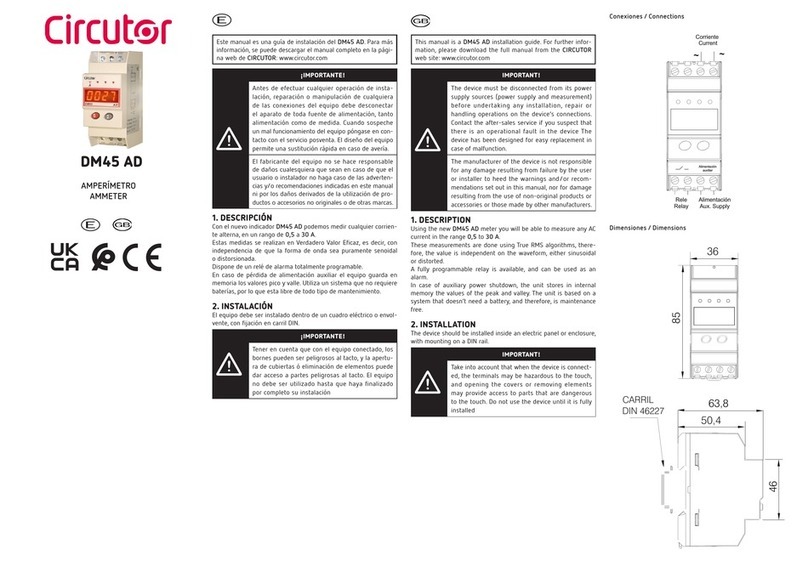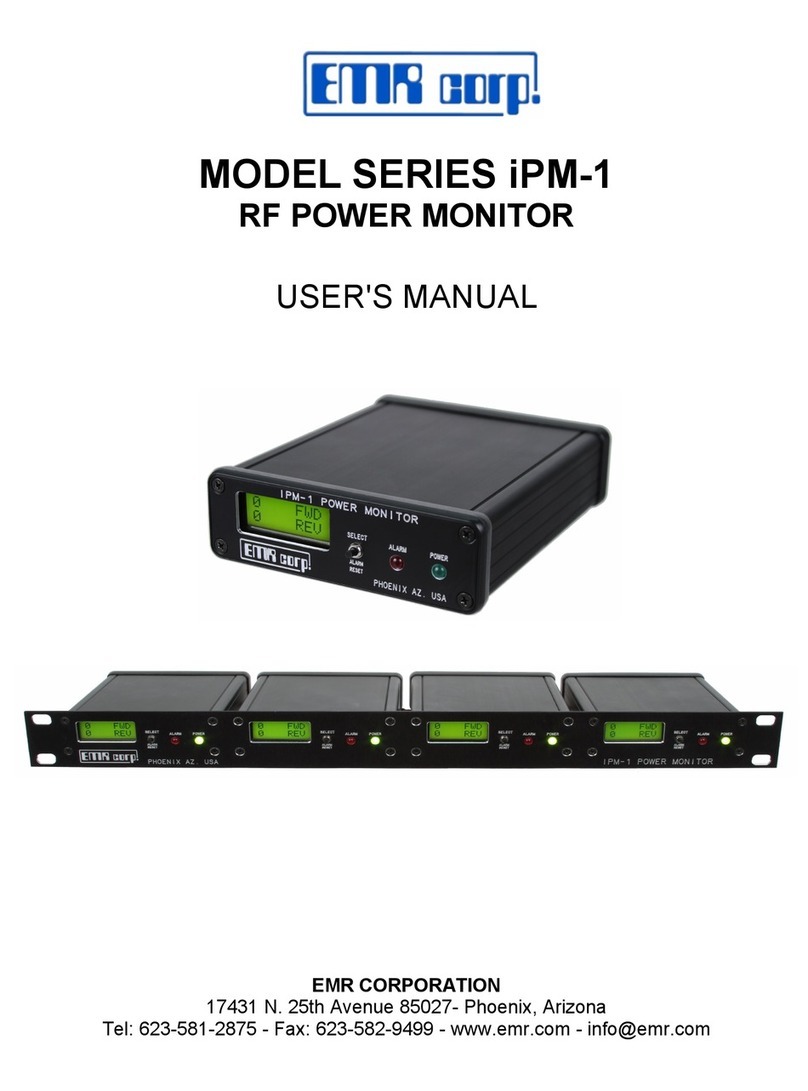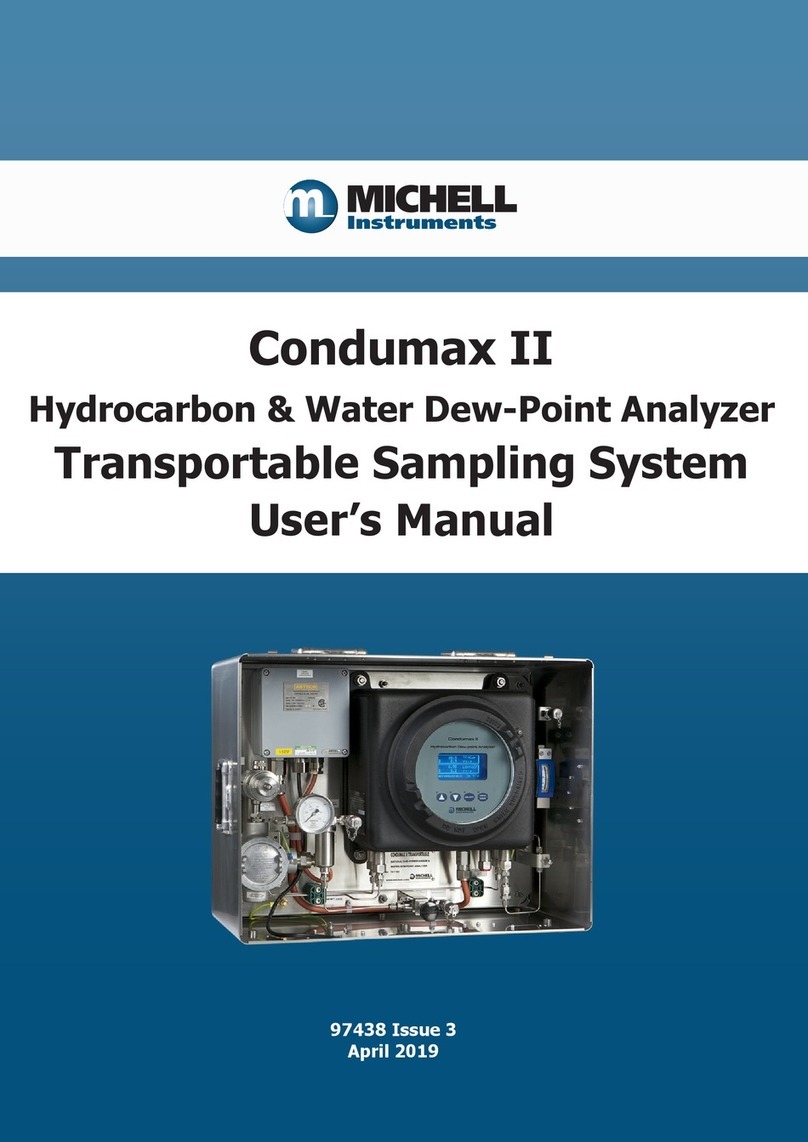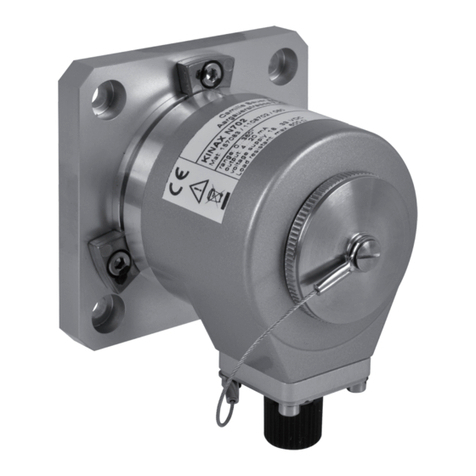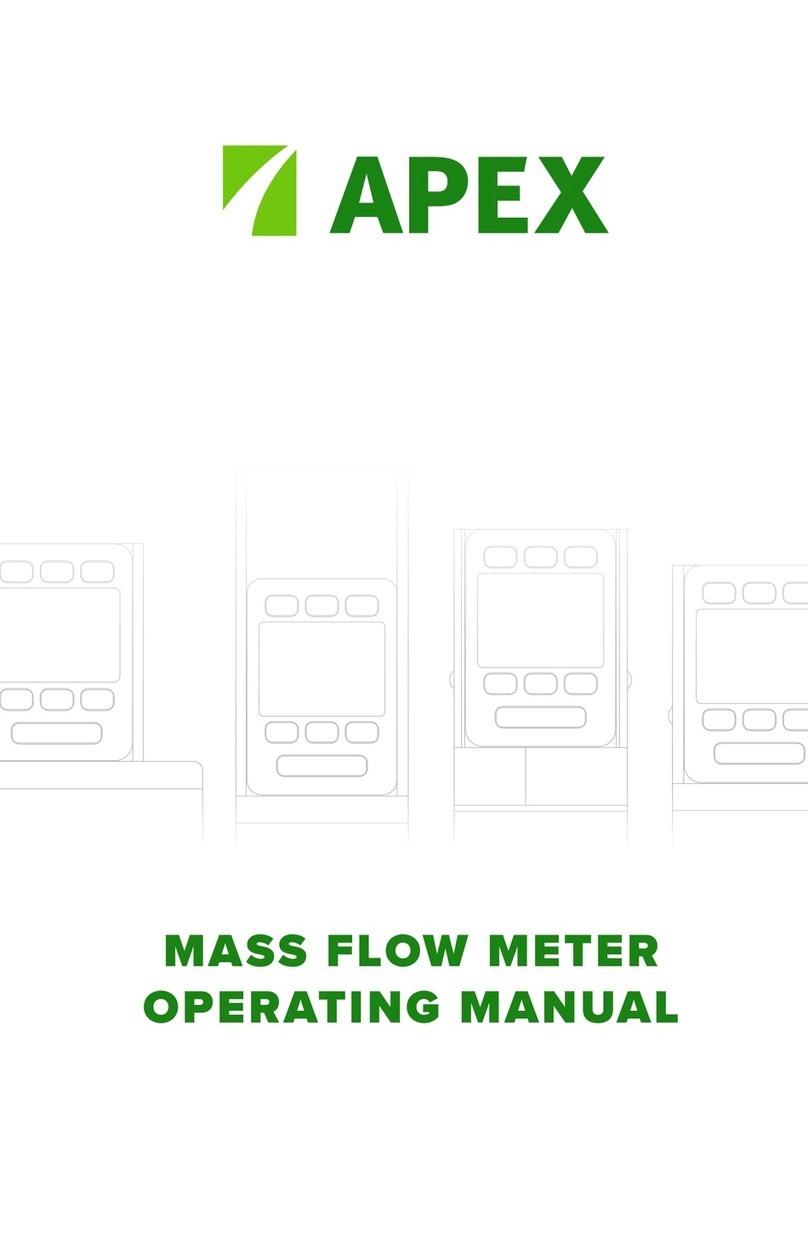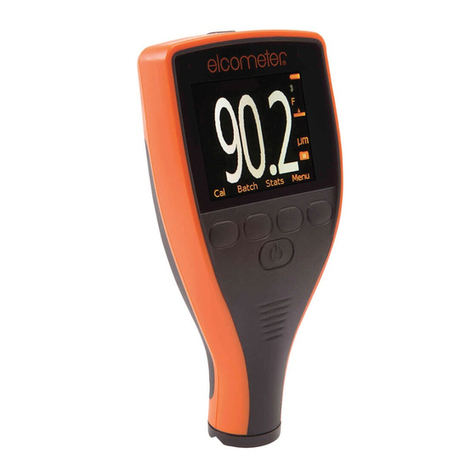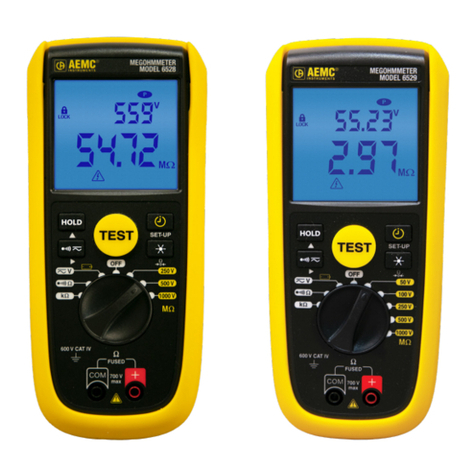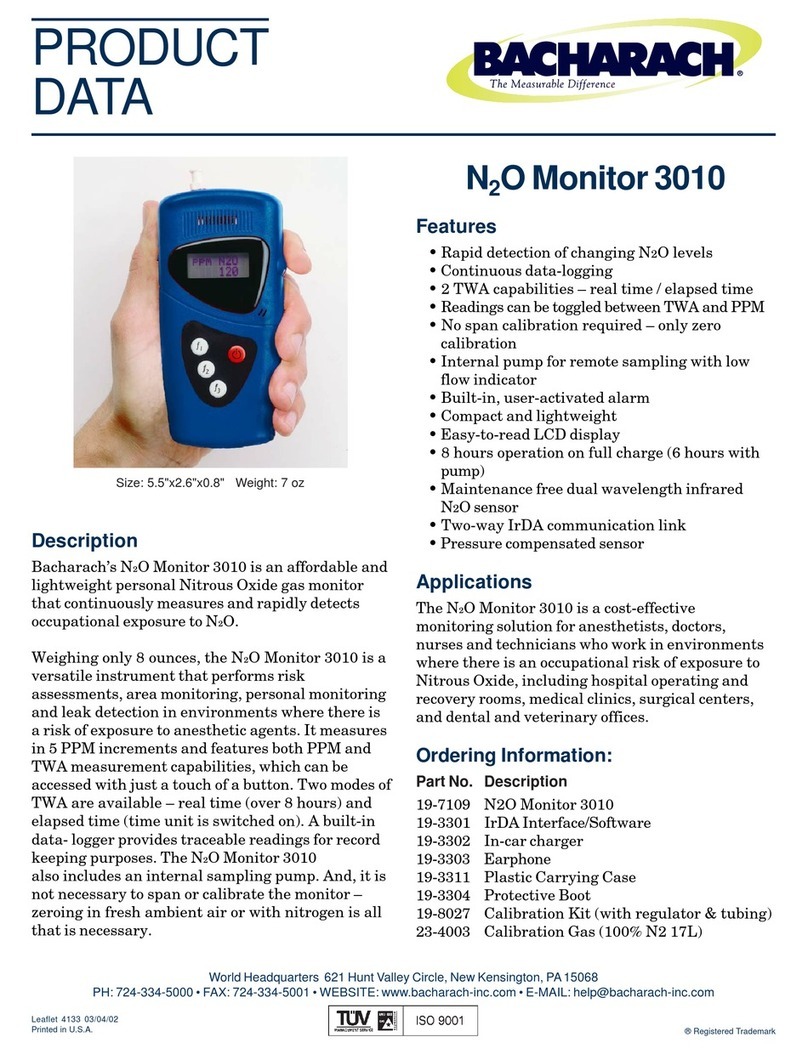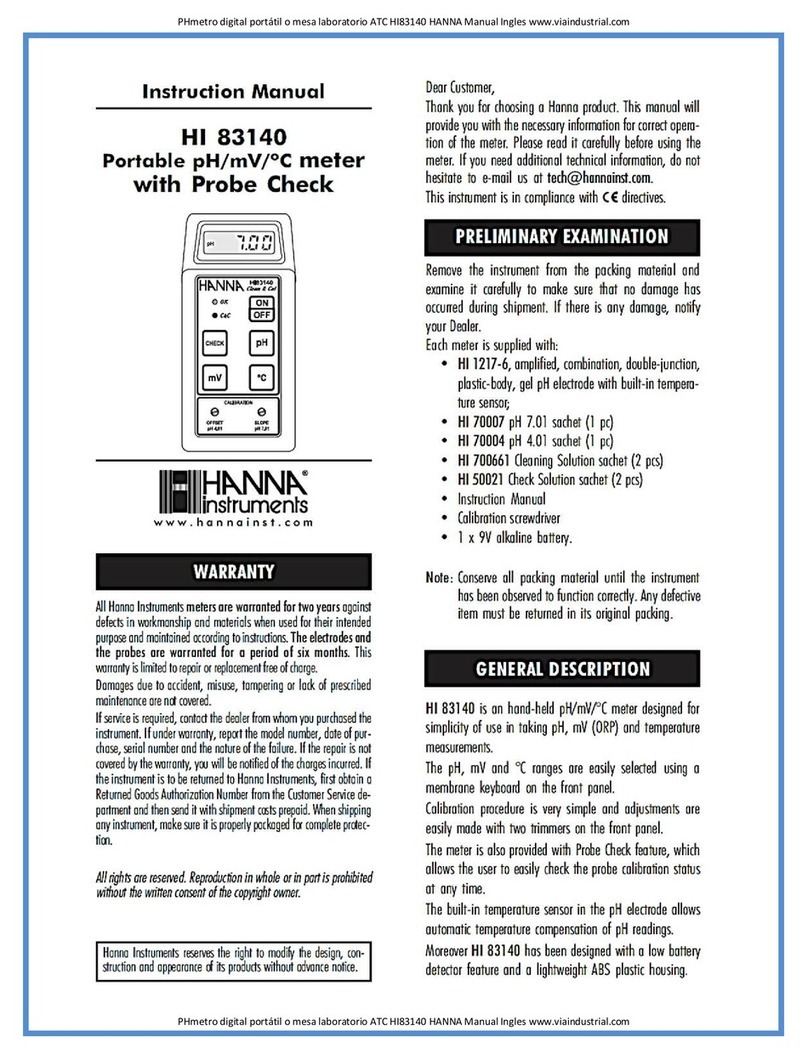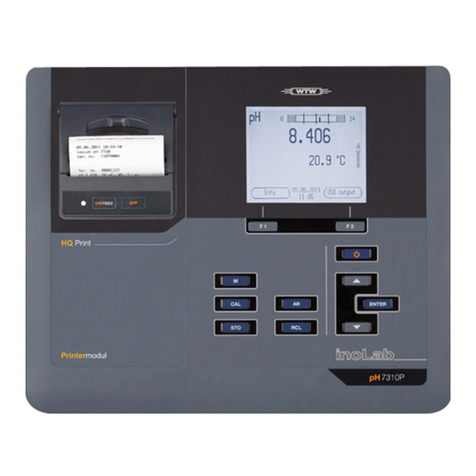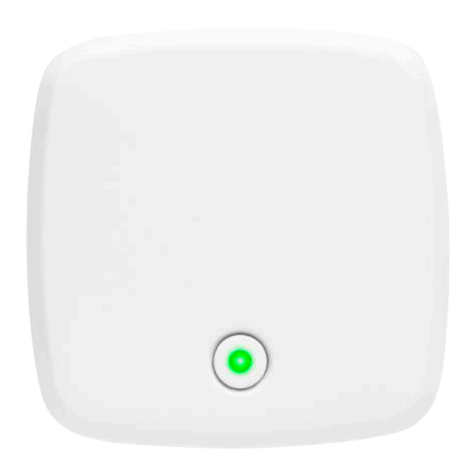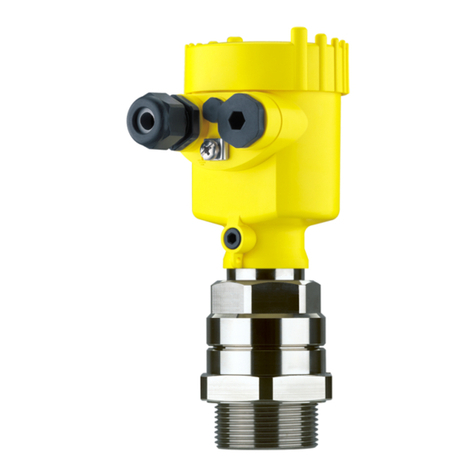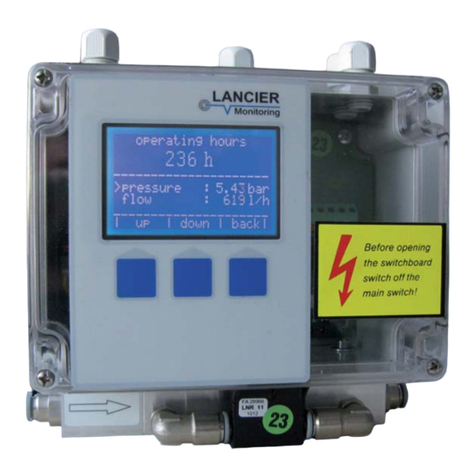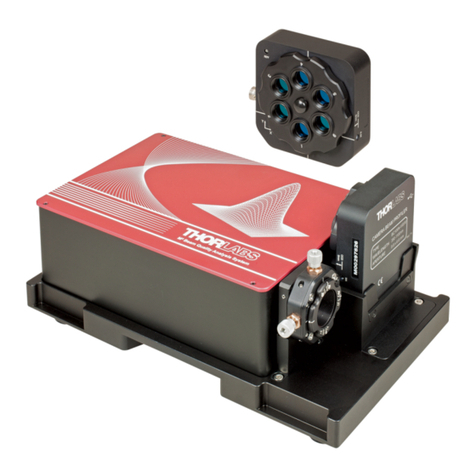Vitrek Xitron 6000-2 User manual

USER’S GUIDE
6000-2 & 6000-3
Phase Angle Voltmeters


Warranty 3
Warranty
This Vitrek instrument is warranted against defects in material and workmanship for
a period of two years after the date of purchase. Vitrek agrees to repair or replace
any assembly or component (except batteries) found to be defective, under normal
use, during the warranty period. Vitrek'sobligation under this warranty is limited
solely to repairing any such instrument, which in Vitrek'ssole opinion proves to be
defective within the scope of the warranty, when returned to the factory or to an
authorized service center. Transportation to the factory or service center is to be
prepaid by the purchaser. Shipment should not be made without prior authorization
by Vitrek.
This warranty does not apply to any products repaired or altered by persons not
authorized by Vitrek or not in accordance with instructions provided by Vitrek. If
the instrument is defective as a result of misuse, improper repair, or abnormal
conditions or operations, repairs will be billed at cost.
Vitrek assumes no responsibility for its product being used in a hazardous or
dangerous manner, either alone or in conjunction with other equipment. Special
disclaimers apply to this instrument. Vitrek assumes no liability for secondary
charges or consequential damages, and, in any event, Vitrek'sliability for breach of
warranty under any contract or otherwise, shall not exceed the original purchase
price of the specific instrument shipped and against which a claim is made.
Any recommendations made by Vitrek or its representatives, for use of its products
are based upon tests believed to be reliable, but Vitrek makes no warranties of the
results to be obtained. This warranty is in lieu of all other warranties, expressed or
implied and no representative or person is authorized to represent or assume for
Vitrek any liability in connection with the sale of our products other than set forth
herein.
Instrument Serial Number: _________________________________________

46000-2 & -3 User Guide, Rev E
Document Part Number MO-6000-M Revision E
Copyright
Copyright© 1995–2005 Vitrek. All rights reserved.
All rights reserved. No part of this publication may be reproduced, transmitted,
transcribed, stored in a retrieval system, or translated into any language in any form
with prior written consent from Vitrek. This product manual is copyrighted and
contains proprietary information, which is subject to change without notice. The
product displays and manual text may be used or copied only in accordance with the
terms of the license agreement.
is a trademark of Vitrek. All other trademarks or
registered trademarks are acknowledged as the exclusive property of their respective
owners.
In the interest of continued product development, Vitrek reserves the right to make
changes in this guide and the product it describes at any time, without notice or
obligation.
Vitrek
Manufacturers of Engineering & Production Test Equipment
12169 Kirkham Road
Poway, CA 92064
(858) 689-2755
E-Mail: [email protected]

Contents 5
Contents
Warranty_________________________________________________ 3
Introduction _____________________________________________ 11
Features _________________________________________________11
Principles of Operation _____________________________________12
Central Processor _______________________________________ 12
Signal Conditioning and DSP Sections ______________________ 13
Input Scaling___________________________________________ 14
Amplitude Measurement Circuitry and DSP __________________ 14
Frequency Measurement _________________________________ 15
Range/Mode Control ____________________________________ 15
Sample Clock Generation _____________________________ 15
Filter Clock Generation _______________________________ 16
Front Panel Operation _____________________________________ 17
Front Panel Operational Features______________________________17
Power Switch __________________________________________ 17
The Display ___________________________________________ 17
Display Select Keys _____________________________________ 18
The Up and Down Arrow Keys ____________________________ 19
The Left and Right Arrow Keys____________________________ 19
Total & Harms Keys_____________________________________ 19
Numeric Entry Keys_____________________________________ 20
Clear & Enter Keys _____________________________________ 20
Store & Recall Keys_____________________________________ 20
Setup Key_____________________________________________ 21
Local Key & Indicator ___________________________________ 21
Calibration Key ________________________________________ 22
Print Key______________________________________________ 22
The Nullmeter _________________________________________ 22
Input Connector Keys & Indicators _________________________ 23

66000-2 & -3 User Guide, Rev E
Making Input Connections___________________________________24
Guard Connections______________________________________ 24
Input Cables ___________________________________________ 25
Using the Operational Keys __________________________________25
Changing Displayed Information or Settings__________________ 25
Setting Defaults ________________________________________ 27
Entering New or Changed Information ______________________ 30
Setting/Formatting Time & Date ___________________________ 31
Storing & Retrieving Configurations___________________________32
Store & Recall Memory Menus ____________________________ 33
Storage Area Maintenance ________________________________ 34
Repacking of the Storage Areas____________________________ 35
Rear Panel ______________________________________________ 37
Connectors & Controls _____________________________________37
Power Connection ______________________________________ 38
Configuration Control Switch _____________________________ 38
Parallel Printer Interface__________________________________ 38
RS232 Connectors ______________________________________ 38
IEEE488 Connector _____________________________________ 38
Configuration Setup_______________________________________ 39
Setup Guidelines __________________________________________39
Input Configuration Menu ___________________________________43
Input Scaling___________________________________________ 43
Guard ________________________________________________ 43
Measurement Configuration Menu ____________________________44
Fundamental Frequency__________________________________ 44
Fundamental Frequency Range ____________________________ 45
Fundamental Source_____________________________________ 45
Nominal Amplitude Measurement Period ____________________ 46
Filter Frequency ________________________________________ 47
Maximum Harmonics____________________________________ 47
Fundamental÷Bandwidth _________________________________ 48
Analysis ______________________________________________ 48
Fundamental Frequency Averaging _________________________ 49
Fundamental Frequency Measurement Period_________________ 49
Nullmeter Display Menu ____________________________________49
Nullmeter Parameter Types _______________________________ 49

Contents 7
Parameter Display Menus ___________________________________50
Parameter (p) __________________________________________ 50
Reference Parameter (r) __________________________________ 54
Reference Parameter Type ________________________________ 54
Data Result Units _______________________________________ 54
Comparison Limit_______________________________________ 55
Filter Time Constant_____________________________________ 56
Some Useful Hints ______________________________________ 56
Showing Percentages & dB Changes_____________________ 56
Unstable Displayed Results ____________________________ 57
Display Line Format _______________________________________57
Nullmeter Scale Menu ______________________________________58
Scale Factor ___________________________________________ 58
Type _________________________________________________ 59
Additional Application Examples _____________________________60
Interface Operation _______________________________________ 63
RS232 Data Format Selection ________________________________63
IEEE488 Interface Setup ____________________________________64
Configuring the Controller Card ___________________________ 65
Configuring the Controller Software ________________________ 66
Interrogating the Data ______________________________________67
Reading Data __________________________________________ 67
Sending Data __________________________________________ 68
RS232 Interfacing_______________________________________ 69
IEEE488 Interfacing_____________________________________ 69
Bus Timing_________________________________________ 69
Bus Commands _____________________________________ 69
Application for the Lower Case Portions of Commands______ 70
Command Set_____________________________________________71
Interface Commands_____________________________________ 71
Available Parameter Strings_______________________________ 74
Retrieving Parameters ________________________________ 75
Source and Bandwidth Strings__________________________ 79
Sub-Definition Strings ________________________________ 80
Special Parameter Strings _____________________________ 81
ID Data Format _____________________________________ 82
UNITS=String Format ________________________________ 82
Full-Parameter Definition Format _______________________ 84

86000-2 & -3 User Guide, Rev E
High Speed Operation ______________________________________85
Measurement Periods____________________________________ 85
Frequency Measurement _________________________________ 85
Harmonic Measurement__________________________________ 85
Interrogating Results ____________________________________ 85
Maintenance & Calibration _________________________________ 87
Daily Maintenance_________________________________________87
Low Level DC Measurements _____________________________ 87
Procedure without Equipment __________________________ 87
Procedure with Equipment_____________________________ 88
External Calibration________________________________________89
Preparation for Calibration________________________________ 90
Required Equipment_____________________________________ 91
Calibration Procedure____________________________________ 91
Performing a Partial Calibration ______________________________93
Performing a Calibration Check Only __________________________93
Appendix A: AIO Option___________________________________ 95
AIO Option Features _______________________________________95
AIO Option Commands_____________________________________95
Appendix B: Specifications _________________________________ 97
Voltage Input _____________________________________________97
Current Input _____________________________________________98
Input Filtering ____________________________________________98
Phase ___________________________________________________98
Fundamental Frequency Measurement _________________________99
Harmonic Analysis_________________________________________99
Peak Parameters__________________________________________100
Date and Time ___________________________________________100
General_________________________________________________100

Contents 9
Figures
Figure 1. System Block Diagram _______________________________________12
Figure 2. Digital Signal Processing Block Diagram_________________________13
Figure 3. Sample Clock_______________________________________________16
Figure 4. The 6000-3 Voltmeter Front Panel ______________________________17
Figure 5. Display Showing Results Data _________________________________18
Figure 6. The Nullmeter ______________________________________________22
Figure 7. Input Terminals _____________________________________________23
Figure 8. Display Line Configuration Data_______________________________26
Figure 9. Rear Panel Partial View_______________________________________37
Figure 10. Initial Setup Display ________________________________________39
Figure 11. Setup Measurements Display__________________________________40
Figure 12. Input Configure Display _____________________________________41
Figure 13. Nullmeter Sample Display____________________________________42
Configuration Examples
ØTo change a display line of Results Data: _______________________________26
ØTo select an option: ________________________________________________26
ØTo set defaults:____________________________________________________27
ØTo abort a displayed menu and discard any changes: ______________________28
ØTo change a display line: ____________________________________________28
ØTo adjust a “noisy” measurement (to a given value): ______________________29
ØTo provide a “fast/medium/slow” style of adjustment capability: ____________29
ØTo add display lines (up to 50 lines possible): ___________________________30
ØTo delete a display line:_____________________________________________30
ØTo add dashes in a display line as a separator: ___________________________30
ØTo “enter” data and changes into the menu—when the cursor is flashing:______30
ØTo “enter” data and changes into the menu—when no cursor is visible: _______31
ØTo adjust the time display:___________________________________________31
ØTo format the time display: __________________________________________32
ØTo set the date format: ______________________________________________32
ØTo set the date display: _____________________________________________32

10 6000-2 & -3 User Guide, Rev E
ØTo store a configuration in an already defined storage area:_________________33
ØTo store a new configuration (presently displaying): ______________________33
ØTo recall a configuration:____________________________________________34
ØTo rename an existing storage area:____________________________________34
ØTo delete a storage area: ____________________________________________34
ØTo manually prompt the repacking of storage areas:_______________________35
ØSetting fundamental frequency mode and range for input connectors: _________39
ØSetting the input mode for each input connector: _________________________41
ØTo change the (input) scale factor: ____________________________________42
ØSetting the Guard connection for each input connector: ____________________42
ØTo configure the Nullmeter parameter display:___________________________42
ØTo complete a configuration setup: ____________________________________43
ØTo measure signal content of harmonics, amplitude, phase, and sync:_________60
ØTo measure harmonic content, or wideband amplitudes synchronously: _______61
ØTo perform spectral analysis of the input signal.__________________________62
ØTo measure wideband amplitudes over a known period of time: _____________62
ØTo perform an external calibration:____________________________________91
ØTo perform a calibration check:_______________________________________93

Introduction 11
Introduction
Congratulations on purchasing one of the high technology signal analysis
instruments available from Vitrek. The 6000 family of Phase Angle Voltmeters
offers the utmost in accuracy and flexibility.
These instruments contain an automatic switching power supply, thus no changes are
required for local AC supply voltage or frequency variations, simply select the power
cord extension that connects to your supplied power.
Features
The Phase Angle Voltmeter instruments are available as a two input, the 6000-2, and
as a three input, the 6000-3. Both have full accuracies available on all inputs fitted.
The following lists some of their significant features.
•Fully digital signal processor (DSP) based operation, no analog phase-locked
loops, phase detectors or other delicate, inaccurate circuitry. These instruments
have a 0.0005Hz to 200kHz range of frequencies.
•True 18-bit resolution on each input, which yields exceptional phase, amplitude
and harmonic resolution.
•500kHz sampling frequency on each input simultaneously, which yields
excellent high frequency accuracies, even with heavily distorted waveforms, and
the widest range of harmonics measurement (up to the 2047th harmonic).
•DSP based fundamental frequency component detection, which yields the widest
range of fundamental “reference” input, even when buried in noise and
distortion.
•Two 40mHz 24-bit Digital Signal Processors for each pair of inputs, and one
68020 32-bit Central Processor, which yields the highest measurement speeds
available.
•Full Range of measurement capabilities, not just amplitude, frequency and
phase. THD, inter-harmonic phase, spectrum analysis, cross-correlation are just
a few of the additional measurements available at the touch of a button.

12 6000-2 & -3 User Guide, Rev E
•Fully customizable display window. Shows 4 lines at a time and is scrollable to
50 lines.
•High resolution bargraph contains 101 elements and two supporting interface
keys.
•Both voltage and current input capabilities on each input, which allows for high
accuracy power measurements from a few nanowatts to hundreds of watts.
•The interface package adds control capabilites with the IEEE488 and RS232
connections; printing capacity with the Parallel printer connectors; and analog
output ability with 12 analog connections, when AIO option is fitted.
Principles of Operation
For basic details regarding the circuitry and methods used in the 6000 instruments,
Figure 1 shows the overall block description of their internal system’s circuitry.
Central Processor
The central processor consists of circuitry surrounding a Motorola 32-bit
MC68EC020 processor and a MC68882 math co-processor, both of which run at
25mHz. These processors perform all interfacing and inter-digital signal processing
and coordination required in the instrument.
Equation
Coprocessor
(MC68882)
Central
Processor
(MC68020)
Signal
Conditioning
and DSPs
(2xDSP56001)
Signal
Conditioning
and DSPs
(2xDSP56001)
Parallel Printer
2 x RS232
IEEE488
Front Panel
Interfaces
Flash
Memory
(up to 4 Mbyte)
A
B
Sync
Option AIO
Figure 1. System Block Diagram

Introduction 13
High Speed
56-bit
Digital
Signal
Processor
(DSP56001)
500KHz
18-bit
Digitizer
High Speed
Digital
LPfilter
(Variable)
500KHz
18-bit
Digitizer
High Speed
Digital
LPfilter
(Variable)
2MHz
8-bit
Digitizer
Analog
LPfilter
(1 MHz)
2MHz
8-bit
Digitizer
Analog
LPfilter
(1 MHz)
Digital
Noisy
Sample
Generator
Optical Isolation Barrier
Digital Peak
Detector
Digital HI-Q
BP Filter
Digital HI-Q
BP Filter
Digital Peak
Detector
Range/Mode
control
SYNCHRONOUS SAMPLE CONTROL
V
A
High Speed
56-bit
Digital
Signal
Processor
(DSP56001)
FREQUENCY MEASUREMENT
RANGE/MODE CONTROL
AMPLITUDE
MEASUREMENT
Range & Mode
The software run by this processor is stored in flash memory, allowing the
instrument’s software to be field upgradeable without requiring removal of the
covers or any circuitry. The interface of this processor to the interface components:
IEEE488, (2) RS232 and Parallel Printer is via the processor’s native bus interface.
This bus interface uses standard commercial integrated circuits for hardware. All of
these interfaces use interrupt driven software to perform their input/output duties,
yielding a high-speed interface.
Signal Conditioning and DSP Sections
For each pair of the instrument’s inputs, there is a set of circuitry that contains two
Motorola DSP56001 24-bit processors interfaced to the central processor. The
interface is made via a high speed RS485 data link. Refer to Figures 1 and 2.
Figure 2. Digital Signal Processing Block Diagram

14 6000-2 & -3 User Guide, Rev E
These sections also provide the primary isolation between the grounded digital
circuitry of the instrument and the floating input circuitry via an optical isolation
barrier, which passes digital signals only.
Each of these sections is capable of operating independently, or can be “joined” to
one or both of the other sections to perform simultaneous sampling, as required, by
the central processor.
Input Scaling
Each input has identical systems that perform the required scaling of the input
signals to the levels required by the amplitude and supervisory systems. Each
input’s scaling is fully differential throughout, and is powered by isolated power
supplies having its common driven by the respective GUARD terminal. In this
manner, excellent common-mode performance is achieved, and the signal quality
delivered to the respective amplitude and supervisory sections is maintained, even in
a digital “backplane” environment. Each input’s scaling and mode is controlled by
parallel digital codes provided by the relevant supervisory DSP. The form of
amplification chosen maintains excellent phase shift, even at high frequencies, using
many gain stages for amplification. Each gain stage is configured to produce the
same nominal phase shift independent of gain setting. Each input system also
presents the GUARD terminal connection to its amplitude and supervisory DSPs to
act as the common for their isolated power supply requirements.
Amplitude Measurement Circuitry and DSP
Each input, after scaling, is filtered by a high speed digital low-pass filter having its
corner frequency (filter clock frequency) controlled by one of three filter clocks
common to all amplitude systems. After filtering, each input signal is then converted
to 18-bit digital form by an 18-bit. analog-to-digital converter system, whose sample
clock is taken from one of three sample clocks common to all amplitude systems.
Each converter consists of a pair of time interleaved 250kHz converters, allowing for
sampling up to 500kHz. Refer to Figure 2, the Digital Signaling Processing Block
diagram.
The output of all four converters (two per input) is read by Motorola’s digital
converter, DSP56001, at a rate controlled by the same sample clock used by the
converters.
This processor performs all amplitude and harmonic analysis required by the system,
and maintains a database of the results of the latest such measurements for its
channel. The central processor gains access to these results via a high speed RS485
data link. This same link is used to pass to the DSP the selections to use for its
sample and filter clock signals, and details regarding the measurements to be made.

Introduction 15
The channel’s circuit board with this harmonic analysis DSP is internally named the
"Amplitude DSP".
Frequency Measurement
Each scaled input passes to a second sub-system for additional analysis. This second
sub-system is internally named the “Supervisor DSP” board and consists of the
following portions:
Filter and High Speed ADC—Each input passes through an analog 1mHz low
pass filter, and sampled at 2mHz by a pair of 8-bit analog-to-digital converters.
Supervisory Processor—The outputs of the pair of 8-bit converters is read by a
Motorola DSP56001, which performs several asynchronous tasks using this data.
This processor is linked to the central processor using the high speed RS485 data
link.
Range/Mode Control
Overload and Underload Detection—Each sample is checked for overload
status. If an overload is detected then the DSP changes the range presented to the
input scaling circuitry (if able) and informs the central processor that a range change
has occurred.
If an underload condition remains for longer than a period provided by the central
processor (actually set by the minimum fundamental frequency expected) then the
DSP changes the range presented to the input scaling circuitry (if able), and informs
the central processor that a range change has occurred. This process is continuous,
independent between the inputs, and completely independent of any other activities
in progress in the instrument. You can also set a fixed range, rather than the above
autorange process.
Bandpass Filtering and Frequency Measurement—Input samples are
passed through a proprietary system. The system performs a tracking bandpass filter
function, maintaining track of the fundamental frequency reading within set range.
This tracked frequency reading is then used to measure the frequency of the
remaining signal component. This process is continuous and independent between
the inputs, and completely independent of any other instrument or supervisory
processor activities in progress.
Sample Clock Generation
Under the direction of the central processor, the supervisory DSP controls circuitry
contained in an ASIC, which generates a digital clock signal whose average

16 6000-2 & -3 User Guide, Rev E
frequency is settable with 20-bit resolution over a 2:1 range of frequencies. This
clock signal is available to all amplitude DSP systems on one of three such signal
lines. If desired by the central processor, the supervisory processor can “link” this
frequency to that of either of its measured input frequencies. The form of the sample
clock is such that the individual sample-to-sample clock period can vary by up to
1%, however, the average over any 256 sample period is always within 1ppm of the
set value. This “jittered” sampling ensures that no input signal component can be
synchronous to the amplitude system’s sample rate, removing the anomalous effects
that occur when this happens.
Figure 3. Sample Clock
Filter Clock Generation
Under the direction of the central processor, the supervisory DSP controls circuitry
contained in an ASIC which generates a digital clock signal whose frequency is
selectable in 1.2:1 steps over 4.5 decades of frequencies. This clock signal is
available to all amplitude DSP systems on one of three such signal lines.

Front Panel Operation 17
Front Panel Operation
This section includes a description of the front panel interface features of the Phase
Angle Voltmeter instruments and their basic operation. Refer to Configuration
Control for an explanation of the menus.
Front Panel Operational Features
The 6000-2 and -3 Phase Angle Voltmeter instruments have a number of controls
and indicators available. See Figure 4.
Figure 4. The 6000-3 Voltmeter Front Panel
Power Switch
Turns the unit ON and OFF.
The Display
The front panel display is a “window” that provides a visual interface to the alpha-
numeric measurement Results Data and the changeable configuration menu. Refer to
Not installed on the 6000-2

18 6000-2 & -3 User Guide, Rev E
Figure 5. The instrument’s display can show (up to) four lines of information at one
time and maintains up to fifty lines of displayable measurement results, which are
accessible by scrolling. You can add or delete lines, as necessary. The display is the
interface focus, as it responds to all front panel key presses, showing the options
available for that key.
rms 118.7 Vrms B
rms 3.410 Arms B
true 350.2 W A
true 404.8 VA A
Figure 5. Display Showing Results Data
The display responds to all front panel keys described below. To place a cursor in a
display line, use a DISPLAY SELECT key, which are the corresponding unmarked keys
on the right. Press the ENTER key once to remove the cursor. Press it twice to action
the configuration.
Display Select Keys
The unmarked keys located to the right of the
display are called the DISPLAY SELECT keys.
The topmost key is 1, second is 2, third is 3, and
forth is 4:
•Use to bring up the configuration for each
line of Results Data, including blank lines.
•Use to place the cursor in the menu display.
•Use to page through the various parameter
screens using the topmost key identified
here as the DISPLAY SELECT 1 key; and
•Use in combination with arrow keys, to
scroll through options to edit a
configuration menu item.
1
2
3
4

Front Panel Operation 19
The Up and Down Arrow Keys
The éand êkeys (up and down arrows) are
part of the DATA ENTRY keypad. Use these keys:
•For scrolling the display Results Data lines,
one line at a time;
•To scroll through selectable options at a
cursor position;
•When no cursor displays, use the éand ê
keys to scroll through various parameter
menu details given in the last three
configuration menu lines.
The Left and Right Arrow Keys
The çand èkeys (left and right arrows) are
part of the DATA ENTRY keypad.
Use these keys:
•To move the cursor to a new selectable
option within a menu line.
•When no cursor displays, use the çand è
keys to scroll through various parameter
menu details given in the last three
configuration menu lines.
DATA ENTRY
Total & Harms Keys
The TOTAL key requests a total value of the
selected parameter item.
The HARMS key toggles the “bandwidth”
selection between AC+DC and a harmonic
range.
TOTAL
HARMS

20 6000-2 & -3 User Guide, Rev E
Numeric Entry Keys
These keys are part of the DATA ENTRY keypad:
•Use the numbered keys to enter numerical
data into the display.
•Use the –(minus sign) to enter negative
integers and to change negative integers to
positive, as required.
•Use the .(decimal point) to enter decimal
values.
•Use the m and Kkeys to designate “micro”
and “kilo”. Note that these keys become
disabled automatically when not applicable.
DATA ENTRY
.
-
0
CLEAR ENTER
Clear & Enter Keys
The CLEAR key is part of the DATA ENTRY
keypad and is used to:
•Discard changes made in either a menu line
or a menu.
•Abandon any change made, restarting the
selection from the beginning.
The ENTER key is part of the DATA ENTRY
keypad and is used to:
•Implement the action per the changes made
in either a menu line or a menu.
•Enter updated data into the menu settings.
DATA ENTRY
CLEAR ENTER
Store & Recall Keys
The STORE and RECALL keys are part of the
CONTROL keypad. These keys are used within
the Configuration Setup menus to:
•Store configurations in the internal non-
volatile “library” (65535 configurations).
•Recall any of the stored configurations.
•Overwrite and remove a configuration,
select or enter the number of an already
defined stored configuration.
Refer to Storing and Retrieving Configurations
on page 32.
SETUP
RECALL
STORE
CONTROL
PRINT
CAL
LOCAL
This manual suits for next models
1
Table of contents
Other Vitrek Measuring Instrument manuals
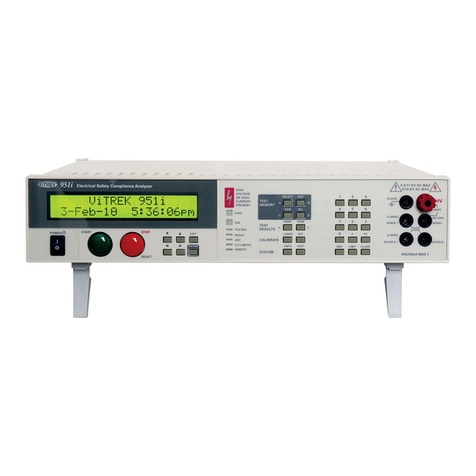
Vitrek
Vitrek 951i Installation and operation manual

Vitrek
Vitrek Xitron 2801 User manual
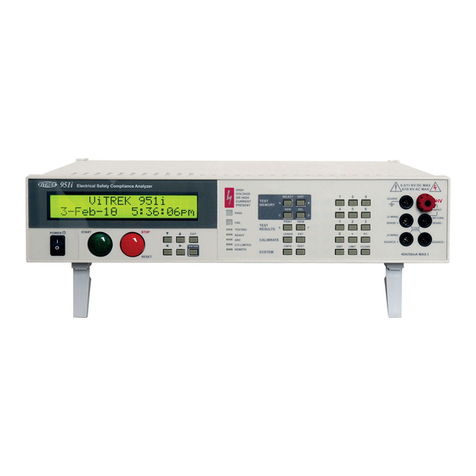
Vitrek
Vitrek 95 Series Installation and operation manual

Vitrek
Vitrek 4700 Operating instructions
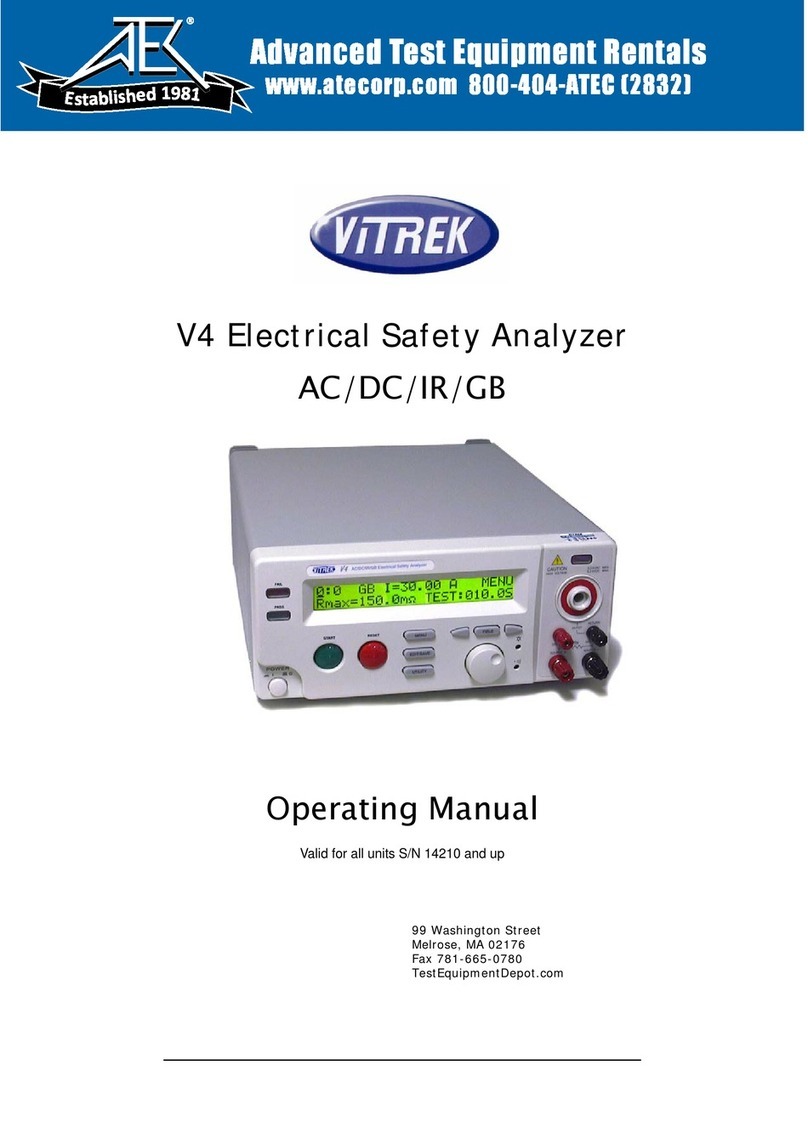
Vitrek
Vitrek V4 User manual

Vitrek
Vitrek 4600A User manual
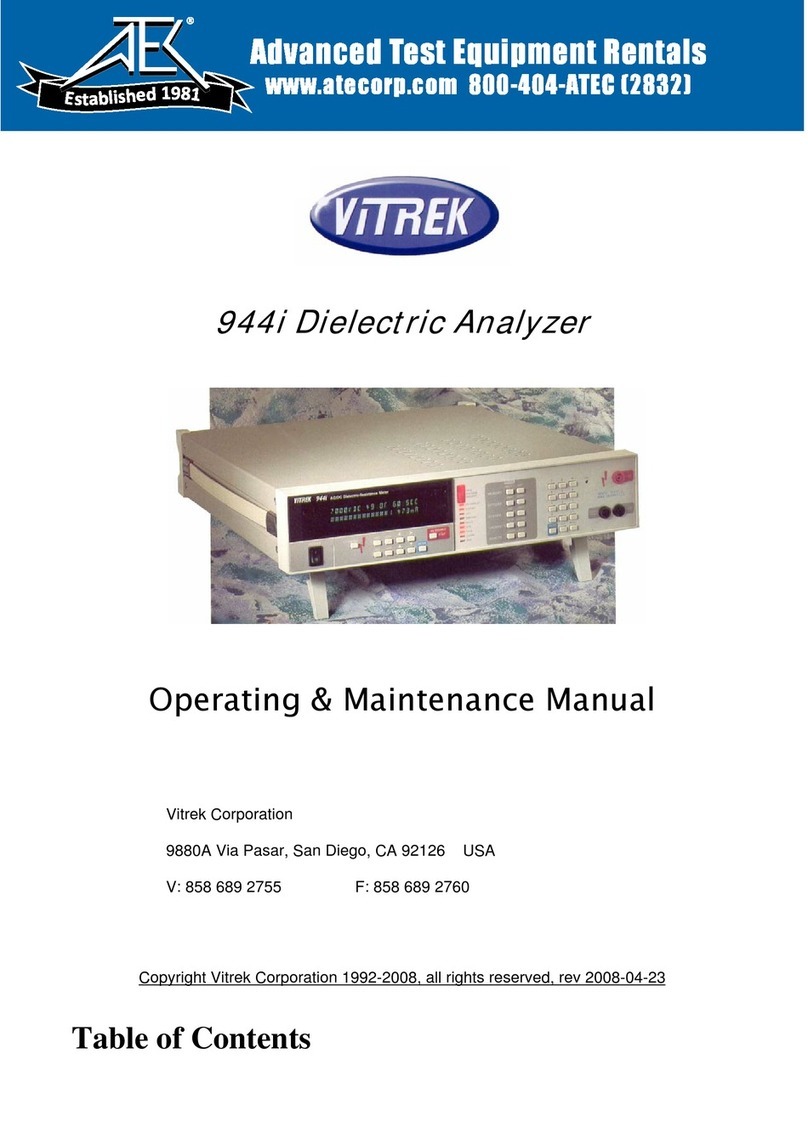
Vitrek
Vitrek 944i Installation and operation manual

Vitrek
Vitrek 930i Installation and operation manual

Vitrek
Vitrek XiTRON XT560 User manual
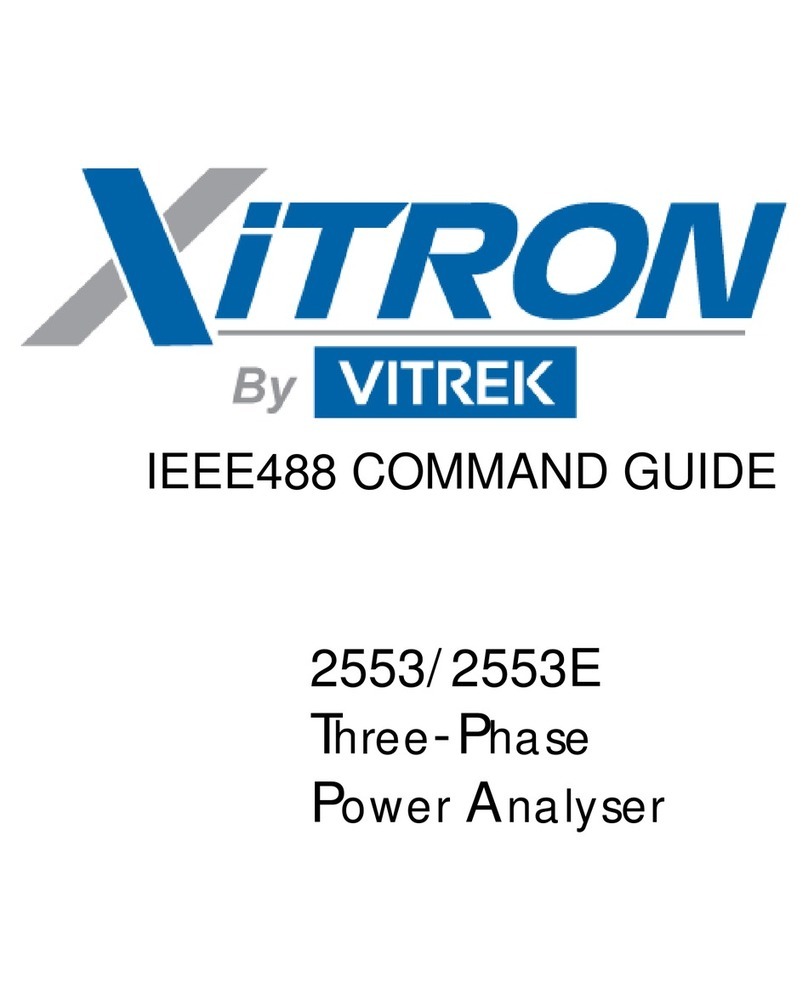
Vitrek
Vitrek Xitron 2553 Installation instructions
